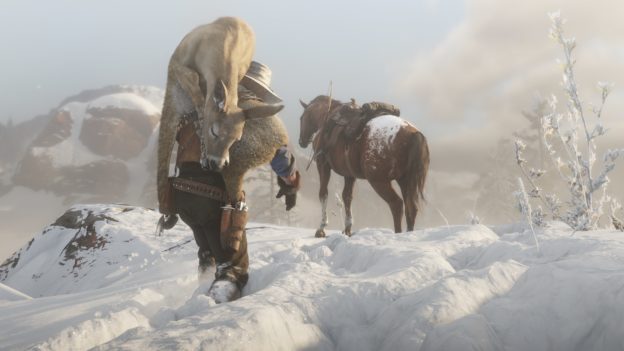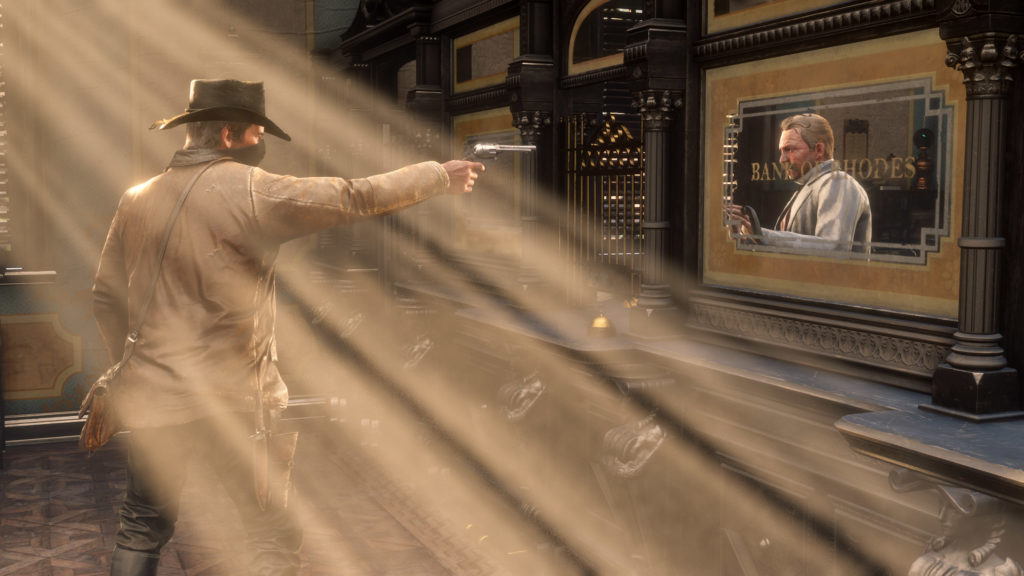Pierre-Yves Donzallaz studied at the University of Fribourg and finished with a B.A. in Computer Science and Information Management. He has been working on several titles of Rockstar Games as Principal Lighting Artist and Lead Level Artist. Here Pierre-Yves talks about his work on Rockstar’s recent masterpiece Red Dead Redemption 2, the importance of lighting, avoiding the uncanny valley and other challenges.
The lighting in the introduction of Red Dead Redemption 2 is just spectacular. I even started feeling slightly chilly in the snow storm. Dispersion of light is extremely resource-intensive. How could it be handled by the PS4?
Pierre Yves Donzallaz: The snowstorm at the start of the game is in fact heavily scripted. Therefore, special optimizations could take place, thanks to the storm heavily limiting the visibility of the world. Furthermore, the unified volumetric lighting system is greatly optimized and can handle a vast range of atmospheric densities and effects, such as dynamic lights injected into the fog system to create atmospheric halos around the gas lanterns, as well as believable clouds of snow blown by the wind. Finally, the mountainous topology of this area means this part of the world is not particularly expensive to render compared to, for instance, the very dense urban environment of Saint Denis, where the base PS4 and Xbox One (S) consoles are really pushed to their limits.
Mounting realism always bears the danger of entering the uncanny valley. What were the directives in this regard? What was defined as no-go area (too much realism)?
As a reminder for the readers, the «uncanny valley» is the strange feeling encountered when dealing with almost-human looking robots or CGI characters that aren’t quite realistic enough to be fully believable.
There is no doubt Red Dead Redemption 2’s characters are among the best seen in a video game so far. However, I’m afraid we are still far from approaching the uncanny valley in games yet. These are still several years behind the movie industry when it comes to character rendering quality, due to the limited power of the console hardware, and the lack of investment in very high-end PC development, apart maybe from the famous Star Citizen. The next generation of consoles will certainly bring major improvements, especially in lighting and hair rendering fidelity.
In addition, the nature of open world games, with their unpredictable dynamic lighting scenarios and highly complex environments, can hinder the ability to reach a quality that, in theory, only more linear and scripted games can achieve. For example, the upcoming The Last of Us Part 2 from Naughty Dog could maybe raise the quality bar even further in terms of character rendering in their scripted cinematics with bespoke lighting, during this console generation.
The atmosphere in RDR2 is second to none. The world truly feels alive. What role does lighting play in these scenes?
The dynamic nature of the lighting, with many different weather conditions and a realistic day-night cycle, reinforces the impression of evolving in a living world. The fantastic work from the graphics programmers and the lighting team made it possible to produce gorgeous landscapes with realistic light scattering and volumetric clouds. For example, the clouds greatly improve the connection between the terrain and the sky, as they cast real-time shadows on the landscape, and the clouds colliding with distant mountains allow for a better perception of the scale of the world.
This level of quality is unprecedented in the open world genre. In comparison, many games these days still rely on skyboxes, which are, simply put, flat static textures which are rendered infinitely far away from the player’s camera and thus are rarely able to provide a sense of connection between the sky and the terrain at the horizon.
Rockstar is always pushing the boundaries. What were the biggest hurdles this time?
The complexity of the game is certainly one of the main challenges. There are so many systems that interact with each other and impact the gameplay and the visuals that it can sometimes be difficult to have a great overview of the game before most systems are in place. Afterwards, it is all about tuning these systems to provide players with a perfectly polished “à la Rockstar” experience. This polishing phase requires a lot of time.
What is your favourite scene in RDR2 and why?
Without spoiling the story, it is a scene in the last part of the game: a group of main characters are celebrating an important life event. It involves them being completely drunk, dancing, wrestling, and having all sorts of goofy activities. This sequence always made me laugh, as the acting is excellent and the light tone heavily contrasts with the serious atmosphere of the game.
RDR2 took seven years to develop. how much time did you work on RDR2?
I worked on RDR2 between 2014 and 2018. From time to time, I was also creating the lighting for the online module of Grand Theft Auto V (GTA Online).
During the production of RDR2, I focused especially on the tools used to create and review the lighting for the hundreds of cutscenes in the game (several hours of footage). Furthermore, I worked on the lighting of several cinematic and interactive scenes, as well as one of the trailers.
You now work for unity and therefore defining the future of games at the core. What ‘s next?
Unity is currently at the forefront of real-time engine development with vast improvements in many departments, such as graphics and performance. The recent Book of the Dead demo, as well as the latest Megacity demo, showcase immense gains in these areas, making Unity a great choice for high-end development too.
Furthermore, the company’s mission is to democratize real-time development, by helping developers to solve difficult problems. New systems such as the Shader Graph, the Visual Effect Graph and the GPU Lightmapper, as well as the incoming improved terrain system, will allow developers to easily create more impressive scenes, faster, more efficiently.
Finally, Unity is also pushing hard in several other industries, such as automotive, architecture, film and simulation. This wide variety of projects is very inspiring and a constant source of learning for me!
The interview with the Swiss artist was conducted by e-mail.



